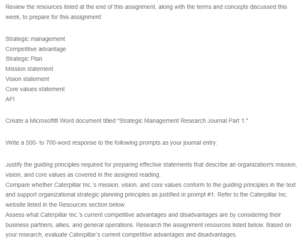Strategic Management Journal
An organization’s mission and vision relate to its purpose and are often expressed in written form. Mission and vision statements seek to answer such questions as what the organization is, what they value, and where they are going. On the other hand, values are a set of beliefs in which the organization is emotionally invested. Research shows that organizations with clear mission and vision statements perform better than those without a clear mission and vision. However, success can only be attained when an organization’s goals, objectives, and strategy are aligned with its mission, vision, and core values.
Guiding Principles for Preparing Effective Statements
Listening to the people is one of the leading guiding principles while preparing a vision, mission, and value statement (University of Minnesota, 2015). People refer to the organization’s employees, management, and other staff in this case. The statements do not have to be exciting to outsiders since it is the people inside the organization who will be charged with the responsibility of implementing them. Involving insiders while drafting core statements will create a sense of collective responsibility to achieve an organization’s core ideologies. Another key guiding principle of a solid and effective statement is an envisioned future. An envisioned future can be a vivid and concrete 10–30-year program, setting goals and how they can be achieved (University of Minnesota, 2015). Putting such a long-term plan in place may seem paradoxical, but it is important since it convinces employees that an organization’s core statements are achievable.
Caterpillar Inc.’s Mission, Vision, and Core Values Conformity with Strategic Plans
Caterpillar’s mission statement comprises four missions that guide the company’s strategic goals. The company’s mission statement is “to provide the best value to customers, grow a profitable business, develop and reward people, and encourage social responsibility.” (Bouchard & Koch, 2014). Since the company competes in a global environment, it must deliver the best quality products and best customer service to have a competitive edge. Besides, the company seeks to bolster shareholder value by actively pursuing high-growth opportunities. Also, Caterpillar rewards its people through internal reward programs designed to encourage productivity.
On the other hand, Caterpillar’s vision statement is “to be a global leader in customer value.” The organization pursues a global business value-creation strategy (Bouchard & Koch, 2014). With a global distribution network, Caterpillar’s customers do not have to worry about how they will ship their products once they make a purchase. The company’s vision statement complies with conventional guidelines for preparing a vision statement- simple and short.
Caterpillar’s Competitive Advantages and Disadvantages
Caterpillar Inc. is known for its high quality and safety standards. Customers globally recognize the company’s high-quality products. In addition, the company has high safety standards at the workplace, besides incorporating safety features on its products. These positive actions have contributed to the company’s global image, leading to more sales. Globalization has presented the consumer with a wide range of products; thereby, only those with a variety for customers to choose from will thrive (Tallman et al., 2017). Another competitive advantage relates to the company’s massive scale and volume. With such huge sales across the globe, Caterpillar’s business growth on the global level is assured. Also, the company’s aggressive investment in research and investment has enhanced the company’s potential in emerging fields of digitization and automation.
The company’s competitive disadvantages include its reliance on heavy machinery. Caterpillar’s typical business model characterizes business-to-business transactions rather than business-to-consumer transactions. Essentially, the company has relied on big companies for decades, and a loss of any of such customers affects its bottom line. Another related point is that the company lacks product diversification. Caterpillar Inc. only sells bulldozers, excavators, engines, and other agriculture/forestry products. However, competitors like Komatsu sell these and other related products, thereby getting a competitive edge.
References
Bouchard, C. T., & Koch, J. V. (2014). The Caterpillar way: lessons in leadership, growth, and shareholder value. Mcgraw-Hill Education.
Tallman, S., Luo, Y., & Buckley, P. J. (2017). Business models in global competition. Global Strategy Journal, 8(4), 517–535. https://doi.org/10.1002/gsj.1165.
University of Minnesota. (2015, October 27). The Roles of Mission, Vision, and Values. Umn.edu; University of Minnesota Libraries Publishing edition, 2015. https://open.lib.umn.edu/principlesmanagement/chapter/4-3-the-roles-of-mission-vision-and-values/.
ORDER A PLAGIARISM-FREE PAPER HERE
We’ll write everything from scratch
Question
Review the resources listed at the end of this assignment, along with the terms and concepts discussed this week, to prepare for this assignment:

Strategic Management Journal
Strategic management
Competitive advantage
Strategic Plan
Mission statement
Vision statement
Core values statement
AFI
Create a Microsoft® Word document titled “Strategic Management Research Journal Part 1.”
Write a 500- to 700-word response to the following prompts as your journal entry:
Justify the guiding principles required for preparing effective statements that describe an organization’s mission, vision, and core values as covered in the assigned reading.
Compare whether Caterpillar Inc.’s mission, vision, and core values conform to the guiding principles in the text and support organizational strategic planning principles as justified in prompt #1. Refer to the Caterpillar Inc. website listed in the Resources section below.
Assess what Caterpillar Inc.’s current competitive advantages and disadvantages are by considering their business partners, allies, and general operations. Research the assignment resources listed below. Based on your research, evaluate Caterpillar’s current competitive advantages and disadvantages.

